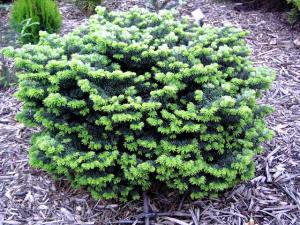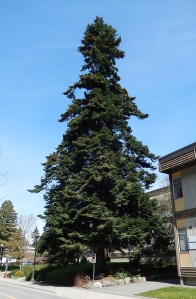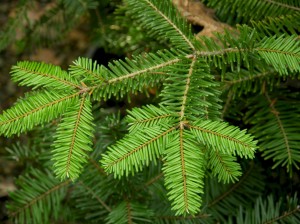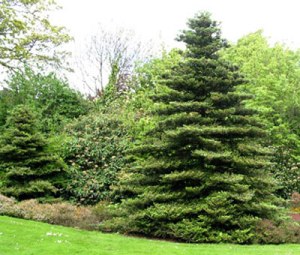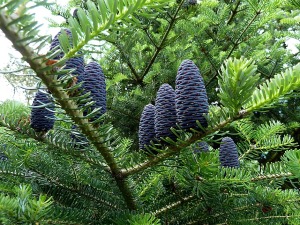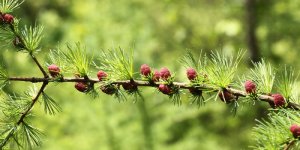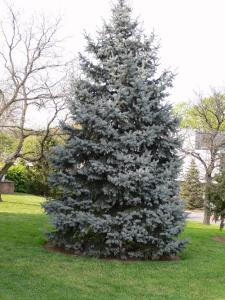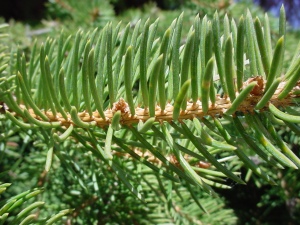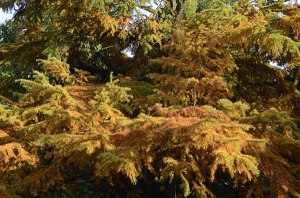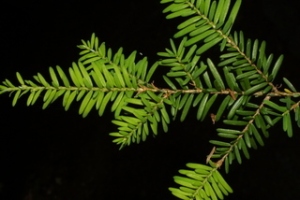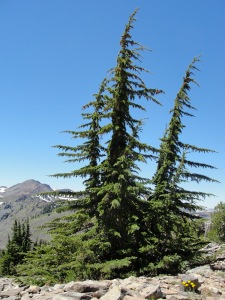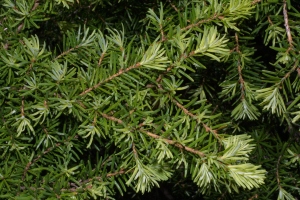November 16-November 20th, 2015
Abies balsamea ‘Nana’
Common name: dwarf balsam fir
Family name: Pinaceae
Leaf: Distinctly fragrant, spiraled, leathery, lustrous, densely arranged flattened dark green needles about 1″, needles are unstalked with circular bases that are embedded in the branch but easily pulled out, 2 distinctive white stomatal bands run vertically along the underside of each needle
Flower:
Fruit/Seed: Aborted or absent
Size: 1-3 ft
Habit: Dense
Form: Mounded
Culture: Full sun to part shade, acidic, rich, consistently moist well draining soil, prefers cooler locations, often affected by urban air pollution
Landscape use: Container, group or mass planting, winter interest, mixed shrub border, ground cover
Origin: Central and eastern Canada, central and northeastern United States
Notes:
Abies grandis
Common name: grand fir
Family name: Pinaceae
Leaf: Needle arrangement resembles the teeth of a two sided comb, flattened, dark green, glabrous, lustrous, distinctive fragrance, 2 white stomatal bands run vertically on the undersides of each needle, needles are 1-2 ”
Flower:
Fruit/Seed: Light green upright cylindrical cones ripening to brown
Size: 25-60 meters
Habit: Upright
Form: Columnar-conical
Culture: Full sun, part sun, part shade, fertile, moist well, slightly acidic well draining soil, sheltered from wind
Landscape use: Forestry, specimen plant, very large tree
Origin: British Columbia, Oregon to Idaho
Notes: Bark has distinctive thin resin blisters
Abies koreana
Common name: Korean fir
Family name: Pinaceae
Leaf: Spiraled, leathery, lustrous, dark green, two broad stomatal bands
Flower:
Fruit/Seed: Erect violet blue cones, showy and distinctive
Size: 7-10 meters
Habit: Upright
Form: Widely pyramidal-conical
Culture: Part sun, part shade, slightly acidic moist well drained soil
Landscape use: Winter interest, tall background, specimen tree, wind break
Origin: Southeast Asia, Japan, China and south Korea
Notes: Distinctive eye shaped scars on bark
Abies lasiocarpa
Common name: subalpine fir
Family name: Pinaceae
Leaf: Spiral,flat and needle like, glaucous with broad tripe of stomata, and two prominent white-blue stripes of stomata underneath
Flower:
Fruit/Seed: Cones are erect, dark blackish-purple with yellow-brown pubescence turning brown before disintegrating and releasing the winged sees
Size: Up to 20 meters
Habit: Upright
Form: Narrowly conical
Culture: Occurs at high altitudes of 300-900 meters in the northern range and 2400-3650 meters in the southern range, rarely at sea level, usually found in or at the tree line
Landscape use:
Origin: Western North America
Notes: Young tree bark is gray, smooth with resin blisters becoming more fissured or scaly as the tree ages, fresh leaf scars are reddish
Cedrus atlantica
Common name: atlas cedar
Family name: Pinaceae
Leaf: Needle like, leathery, bluish-green, spiraled, linear, acute, in clusters on short spurs or alternately on longer stems
Flower:
Fruit/Seed: Erect male cones, green, brown and showy
Size: Up to 30 meters
Habit: Horizontal, open
Form: Widely pyramidal
Culture: Full sun, acidic well draining soil
Landscape use: specimen, tall background, windbreak
Origin: Africa, Europe
Notes:
Cedrus deodara
Common name: Deodar cedar
Family name: Pinaceae
Leaf: Needle like, whorled-spiraled, arranged in clusters on spurs
Flower:
Fruit/Seed: Erect, yellow-brown male cones
Size: Up to 30 meters
Habit: Horizontal, upright
Form: Oval-horizontal, widely pyramidal
Culture: Full sun, well drained soil
Landscape use: Specimen tree
Origin: South Asia, India
Notes:
Cedrus libani
Common name: Lebanon cedar
Family name: Pinaceae
Leaf: Long shoots and short shoots, dark green-gray, borne in whorls
Flower:
Fruit/Seed: Barrel shaped, dull green female cones
Size: Up to 40 meters
Habit: Widely spreading branches
Form: Conical when young, flat-topped when mature
Culture: Open sunny, any well drained soil
Landscape use: Specimen tree
Origin: Mediterranean mountains, Lebanon to Turkey
Notes: Black-brown bark, scaly fissures and ridges
Larix sp.
Common name: larch
Family name: Pinaceae
Leaf: Yellow to red autumn colour, needle like borne in loose spirals on long shoots and whorl like on the short shoots
Flower:
Fruit/Seed: Terminal, erect ovoid-conical purplish female cones, turning brown and woody in the spring, male cones are pink-yellow ovoid to spherical
Size: Up to 45 meters
Habit: Upright
Form: Broadly pyramidal
Culture: Full sun, deep well draining soil
Landscape use: Specimen plant, tolerant of a range of conditions
Origin: Russia, Canada, Scandinavia
Notes:
Picea abies
Common name: Norway spruce
Family name: Pinaceae
Leaf: Spiraled, short and prickly, glabrous, needles leave pegs when removed, needles are blunt and point forward and upward on the shoots
Flower:
Fruit/Seed: Cones are green turning brown, erect when flowering and pendent later on
Size: 22-30 meters
Habit: Stiffly upright, pendulous branches
Form: Conical when young, columnar when mature
Culture: Full sun, part sun, part shade, acidic well drained soil
Landscape use: Specimen, screening, forestry, windbreak
Origin: Europe
Notes: Most commonly cultivated spruce
Picea glauca
Common name: white spruce
Family name: Pinaceae
Leaf: Spiraled, needle like, bluish green,
Flower:
Fruit/Seed: Green cones turning light brown
Size: Up to 50 meters
Habit: Upright
Form: Narrowly-broadly conical
Culture: Full sun, part sun, moist acidic soil
Landscape use: Forestry, specimen
Origin: Canada
Notes:
Picea omorika
Common name: Serbian spruce
Family name: Pinaceae
Leaf: Spiraled, leather, flexible, glabrous
Flower:
Fruit/Seed: Brown cones in clusters
Size: 15-22 meters
Habit: Stiffly upright, pendent branches
Form: Narrow, spire-like
Culture: Full sun, part sun, part shade, deep moist well draining neutral to acidic soil, tolerates alkaline soil
Landscape use: Hedge row, specimen, winter interest
Origin: Europe
Notes:
Picea pungens
Common name: Colorado blue spruce
Family name: Pinaceae
Leaf: Spiraled, prickly, glabrous, bluish
Flower: Brown cones
Fruit/Seed:
Size: 15-22 meters
Habit: Horizontal, stiffly upright
Form: Conical to columnar
Culture: Full sun, deep acidic well draining soil
Landscape use: Alpine, screening, specimen, winter interest
Origin: Northwest United States
Notes:
Pseudolarix amabilis
Common name: golden larch
Family name: Pinaceae
Leaf: Tuft like clusters on short shoots, light green foliage above and blue-green below turning yellow-orange before dropping in the fall, needles are generally longer and broader than that of the true Larix
Flower:
Fruit/Seed: Cones are larger than true Larix and male catkins are borne in clusters not singly like on true Larix
Size: Up to 18 meters
Habit: Horizontal branching, pendent branchlets
Form: Broadly conical
Culture: Moist acidic organic soil in full sun protected from strong winds
Landscape use: Specimen for large are, needs a large area to grow as it can become as wide as it is tall
Origin: Eastern China
Notes:
Pseudotsuga menziesii
Common name: Douglas fir
Family name: Pinaceae
Leaf: Alternate spiraled, glabrous, suction cup like petioles attach needles to branch
Flower:
Fruit/Seed: Male cones small and inconspicuous, female cones easily identifiable by trident shaped bracts that resemble mice butts with tails as if they were crawling into the cone
Size: Up to 50 meters
Habit: Horizontal upright
Form: Widely pyramidal
Culture: Full sun , moist acidic well draining soil
Landscape use: Forestry, native planting, specimen tree for large area, woodland margin
Origin: British Columbia to California
Notes: Tip of the tree usually bent slightly, easy to identify from far away
Tsuga heterophylla
Common name: western hemlock
Family name: Pinaceae
Leaf: Needle like, alternate, flat, glabrous, lustrous, soft and flexible, appear to be 2 ranked on twig, rounded apex and base
Flower:
Fruit/Seed: Small green cones turning brown
Size: Up to 30 meters
Habit: Stiffly upright
Form: Widely pyramidal
Culture: Full sun, part sun, part shade, moist acidic well drained soil
Landscape use: Forestry, hedgerow, specimen, winter interest, reclamation, native planting, tall background
Origin: Alaska to California
Notes: Nodding tree top droops to one side, deeply fissured grey-brown bark
Tsuga mertensiana
Common name: mountain hemlock
Family name: Pinaceae
Leaf: Thick blunt tipped needle like, spiraled, glabrous, bluish-green
Flower:
Fruit/Seed: Blue-black cones, turning brown, pendulous
Size: 10-15 meters
Habit: Pendulous, upright
Form: Columnar-conical
Culture: Full sun, part sun, part shade, humus rich, moist well drained soil
Landscape use: Screening, wildlife food, winter interest, specimen plant, tolerant of wet soils, bog planting,
Origin: Alaska to California
Notes:
